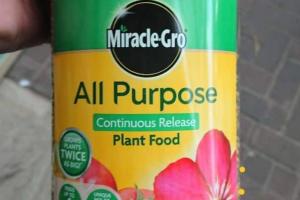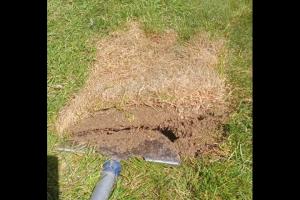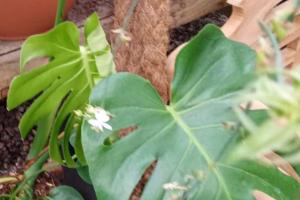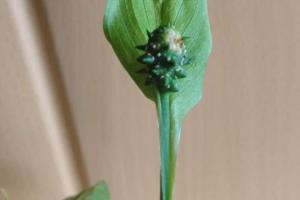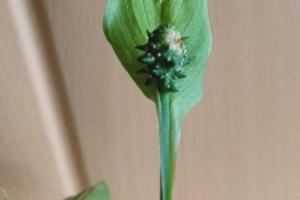How to Grow and Care for Monstera Deliciosa
Monstera deliciosa (aka the Swiss cheese plant) is one of the most popular low maintenance houseplants for beginners, revered for its stunning split leaves.
Whilst monstera plants are easy to care for, it is important to note that they are tropical in origin preferring high humidity and loose soil, therefore it is important to know some specific details pertaining to their care to grow them successfully.
Here is a table summarizing the care requirements of monstera deliciosa:
| How to Care for Monstera Deliciosa: | Monstera Deliciosa Care Requirements: |
| Light: | Monstera need bright indirect light. Too much direct sunlight scorches the leaves, not enough light prevents the leaves from splitting. |
| Location: | Keep monstera out of the current of air conditioning and on the other side of the room from indoor heating. |
| Best Potting Soil: | Monstera need a loose aerated soil so mix 2/3’s potting soil with 1/3 orchid potting mix or perlite. |
| Best Pots: | Terracotta or unglazed clay are the best as they dry out evenly preventing root rot. However monstera can grow in plastic and ceramic pots if they have a drainage hole and are watered carefully. |
| How Often to Repot Monstera: | Repot monstera every 2-3 years or whenever you can see roots visibly emerging from the soil in a pot bound fashion. |
| Use a moss pole for support: | Mature monstera plants ideally need a moss or coir pole for the aerial roots to attach to support the plant as it is naturally a climbing vine. |
| How Often to Water Monstera in Summer: | Typically watering every 7 days meets the watering requirements without risking root rot, however always ensure the top inch of potting soil feels dry before watering. |
| How Often to Water Monstera in Winter: | Typically watering every 10 days meets the watering requirements in Winter but always check to see if the top inch of soil has dried before watering. |
| Humidity: | Monstera prefer higher humidity (around 30%) but can adapt to lower levels. If the leaves start curling or turning brown at the edges, mist the leaves to increase humidity. |
| Wipe the Leaves every Month: | Use a damp cloth to clean the leaves every month or so to stop them accumulating too much dust which can interfere with photosynthesis. |
| How Often to use Fertilizer: | Use a general all purpose houseplant fertilizer every month in the Spring and Summer. Do not use any fertilizer in the Fall and Winter. |
| Temperature: | Monstera can withstand temperatures as low as 50°F (10°C) but 65°F to 85°F (18°C to 29°C) is the optimal temperature range from growth. |
Best Light and Location for Monstera (Bright, Indirect Light)
Monstera deliciosa need bright, indirect light to grow well indoors. Bright light ensures the monstera has the energy it needs to produce more of its large leaves with their characteristic fenestrations.
Monstera deliciosa grow naturally up trees in bright light but they are protected from intense sunlight by the canopy overhead.
Typically I find that monstera grow best in rooms with a South facing window, but locate a few feet away from the window to avoid any direct light.
If the monstera does not have bright enough light they tend to not grow as well, droop over and anecdotally I have noticed that the leaves are smaller with fewer holes.
Whilst monstera can tolerate some morning sun, the leaves tend to scorch brown in direct sunlight, particularly afternoon sun from which they do not recover, so it is important to find the right balance of bright, indirect light.
Monstera are native to humid tropical environments so they prefer not to be locate in the direct path of air currents from air conditioning, open doors or convection currents from sources of heat.
Monstera do appreciate air circulation form a gentle breeze from and open window every so often.
Monstera grow very well in the more humid rooms of the house such as bathrooms, but can grow in any room as long as you are able to increase the humidity with misting or by using a humidifier.
Best Soil for Monstera (Best Potting Mix)
The best potting soil for growing monstera deliciosa is a mix of 2/3’s normal houseplant potting soil mixed with 1/3 pine bark based potting mix.
I have personally found that a mix of potting soil and pine bark is best as the soil retains enough moisture to meet monstera plant’s needs whilst the pine bark creates an aerated soil structure that allows excess water to drain away easily.
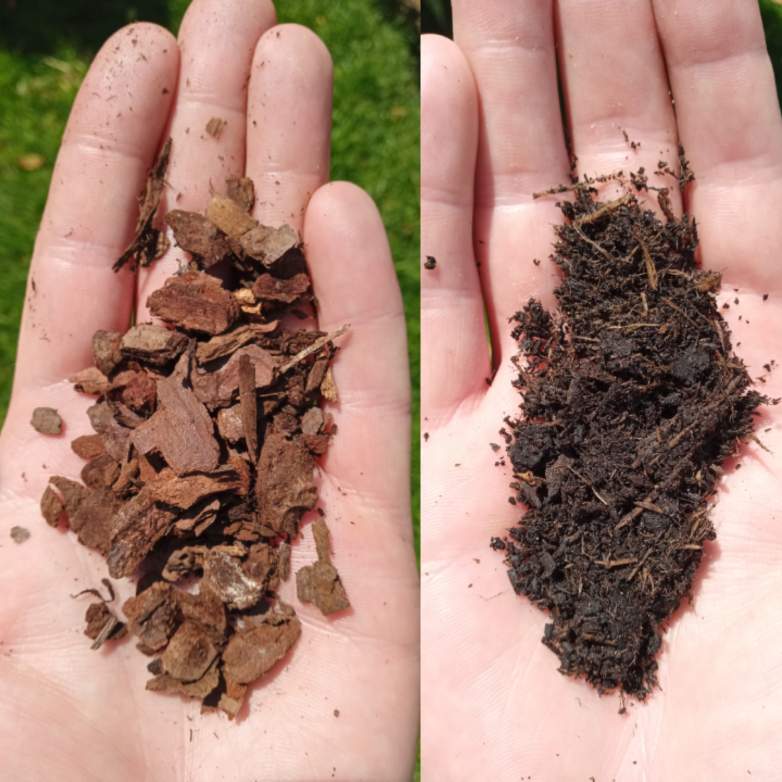
Monstera also grow as a hemi epiphytic vine in their natural environment with their roots growing up other trees, so the pine bark also mimics their natural growing conditions to some extent.
You can also grow monstera in a potting mix with perlite (if your do not have any pine bark to hand) as perlite also create the aerated soil structure around the roots of the monstera providing the optimal balance between retaining some moisture and good drainage.
If you do not amend the monstera’s potting soil with either perlite or pine bark then the potting mix may be too dense which restricts that amount of oxygen around the roots and retain moisture for too long for the monstera to tolerate which results in root rot.
Best Type of Pot For Monstera Deliciosa
The best pots for monstera plants are unglazed clay and terracotta pots as they are porous which allows the potting soil to dry out more evenly which mitigates the risk of root rot whereas plastic and ceramic pots are impermeable and can retain too much moisture for the monstera to tolerate.
Ensure the pot has a drainage hole in the base as monstera do not tolerate saturated soil.
Clay and terracotta pots are also heavier then plastic pots which can act as a counter balance, preventing top heavy monstera from toppling over.
Monstera can grow in plastic or ceramic pots as long as they have drainage holes in the base and you check the soils moisture diligently to make sure it does not stay damp for too long.
How Often to Repot Monstera Deliciosa (Every 2-3 Years)
It is best practice to repot monstera every 2 to 3 years in a pot that is only 2 inches larger in diameter then the previous pot. If you repot your monstera to a much larger pot then the soil dries out at a much slower rate which can increase the risk of root rot.
Take your monstera out of its original pot and discard any soil around the rootball as this soil may be compacted (which reduces the rate of drainage) or decomposed to the point it retains too much moisture.
I personally recommend placing some crocs or mesh over the drainage hole to prevent any excess soil falling out the bottom of the pot (depending on the size of the drainage hole).
Place your monstera in its new pot and backfill the potting mix around the roots. As stated, I personally recommend a mix of 2/3’s potting soil mixed with 1/3 orchid pine bark based potting mix.
Do not compress the soil too firmly around the roots as this push oxygen out of the soil, decreasing the rate of drainage and reducing root respiration.
After repotting give the potting mix a good soak, making sure that the potting mix is evenly moist. Be aware that the soil is likely to dry out at a slower rate in the larger pot so check the soil’s moisture before watering.
Use a Moss Pole When Repotting Monstera Deliciosa To Prevent Drooping
Monstera are hemi epiphytes which means they use aerial roots to climb up trees in their native environment.
A moss or coir pole provides more mature monstera plants with a structure to climb which prevents it from drooping over and creates a tall dramatic look to your plant, rather then sprawling all over the floor.
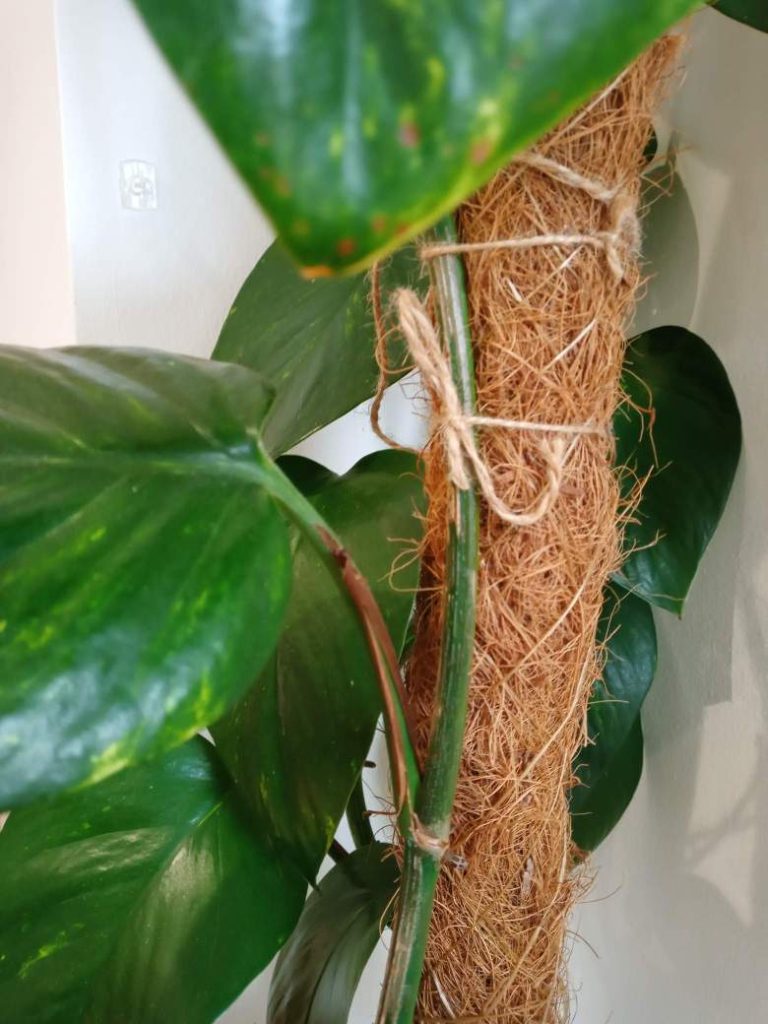
It is not necessary to have a moss pole for a monstera when they are not mature as they can grow without support.
However I personally recommend buying one when you see aerial roots forming to prevent any drooping growth.
The moss pole has a tactile texture for the roots to attach to and the moss (or coir) can absorb water when it is misted which helps to create a humid micro climate for your monstera to thrive.

How Often To Water Your Monstera Plant
Monstera need the top inch of the soil to dry out between bouts of watering to meet the monstera’s watering requirements and avoid root rot. Typically in most climates this means you should water monstera with a generous soak once per week, ensuring that the potting soil is evenly moist.
However, how often you should monstera can vary according to:
- The size of the pot (larger pot dry more slowly).
- How much the potting soil retains moisture.
- Temperature and humidity.
- Time of year.
Therefore I always recommend feeling the soil to an inch depth with your finger to accurately detect when the top inch of soil feels dry.
In my experience this is always best done by touch as I find it is more precise then using moisture meters which I find are too variable be useful.
Once you have established how long it typically takes for the top inch of the monstera’s potting soil to dry you can establish a watering schedule for your monstera according to your home environment.
How Often to Water Monstera In Summer
It is important to emphasize that the monstera’s demand for moisture increases in the Spring and Summer during active growth, particularly in the Spring if you are using fertilizer which can accelerate growth.
Additionally if your in a hot and dry climate, it may be necessary to water monstera every 5-7 days as low humidity can sap water from the leaves and high temperatures increase evaporation from the soil.
As long as you check that the top inch of soil dries before watering then the monstera will grow and thrive.
How Often to Water Monstera In Winter
Water monstera plants every 7-10 days in Winter ensuring that the top inch of the soil dries between each watering.
The monstera’s growth rate decreases significantly in response to fewer hours of daylight which reduces the rate at which the roots uptake moisture. This can cause the monstera’s potting soil to remain damp for too long.
However, if you are using indoor heating in Winter, this can dry out the potting soil and sap moisture from the leaves so always locate your monstera on the other side of the room as mist the leaves regularly to maintain a humid micro climate to prevent the leaves turning brown at the edges.



